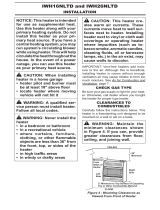
111487-01A
For more information, visit www.desatech.com
For more information, visit www.desatech.com
4
AIR FOR COMBUSTION AND
VENTILATION
Today’s homes are built more energy efficient than ever. New materi-
als, increased insulation, and new construction methods help reduce
heat loss in homes. Home owners weather strip and caulk around
windows and doors to keep the cold air out and the warm air in. During
heating months, home owners want their homes as airtight as possible.
While it is good to make your home energy efficient, your home
needs to breathe. Fresh air must enter your home. All fuel-burning
appliances need fresh air for proper combustion and ventilation.
Exhaust fans, fireplaces, clothes dryers, and fuel burning appliances
draw air from the house to operate. You must provide adequate fresh
air for these appliances. This will insure proper venting of vented
fuel-burning appliances.
PROVIDING ADEQUATE VENTILATION
The following are excerpts from National Fuel Gas Code,
ANSI Z223.1/NFPA 54, Section 5.3, Air for Combustion and
Ventilation.
All spaces in homes fall into one of the three following ventilation
classifications:
1. Unusually Tight Construction
2. Unconfined Space
3. Confined Space
The information on pages 4 through 6 will help you classify your
space and provide adequate ventilation.
Unusually Tight Construction
The air that leaks around doors and windows may provide enough
fresh air for combustion and ventilation. However, in buildings of
unusually tight construction, you must provide additional fresh air.
Unusually tight construction is defined as construction
where:
a. walls and ceilings exposed to the outside atmo-
sphere have a continuous water vapor retarder with
a rating of one perm (6 x 10
-11
kg per pa-sec-m
2
) or
less with openings gasketed or sealed
and
b. weather stripping has been added on openable win-
dows and doors
and
c. caulking or sealants are applied to areas such as
joints around window and door frames, between sole
plates and floors, between wall-ceiling joints, be-
tween wall panels, at penetrations for plumbing, elec-
trical, and gas lines, and at other openings.
If your home meets all of the three criteria above, you
must provide additional fresh air. See
Ventilation Air
From Outdoors
, page 6.
If your home does not meet all of the three criteria above,
proceed to
Determining Fresh-Air Flow For Heater Loca-
tion,
page 5.
Confined and Unconfined Space
The National Fuel Gas Code ANSI Z223.1/NFPA 54 defines a
confined space as a space whose volume is less than 50 cubic feet
per 1,000 Btu per hour (4.8 m
3
per kw) of the aggregate input rating
of all appliances installed in that space and an unconfined space as
a space whose volume is not less than 50 cubic feet per 1,000 Btu per
hour (4.8 m
3
per kw) of the aggregate input rating of all appliances
installed in that space. Rooms communicating directly with the
space in which the appliances are installed*, through openings not
furnished with doors, are considered a part of the unconfined space.
* Adjoining rooms are communicating only if there are doorless
passageways or ventilation grills between them.
WARNING: This heater shall not be installed in a
confined space or unusually tight construction unless
provisions are provided for adequate combustion and
ventilation air. Read the following instructions to in-
sure proper fresh air for this and other fuel-burning
appliances in your home.
LOCAL CODES
Install and use heater with care. Follow all local codes. In the absence
of local codes, use the latest edition of The National Fuel Gas Code
ANSI Z223.1/NFPA 54*.
*Available from:
American National Standards Institute, Inc.
1430 Broadway
New York, NY 10018
National Fire Protection Association, Inc.
Batterymarch Park
Quincy, MA 02269
OPERATION
This heater is clean burning. It requires no outside venting. There is no
heat loss out a vent or up a chimney. Heat is generated by realistic,
dancing yellow flames. This heater is designed for vent-free operation.
State and local codes in some areas prohibit the use of vent-free heaters.
SAFETY PILOT
This heater has a pilot with an Oxygen Depletion Sensing (ODS) safety
shutoff system. The ODS/pilot is a required feature for vent-free room
heaters. The ODS/pilot shuts off the heater if there is not enough fresh air.
PIEZO IGNITION SYSTEM
This heater has a piezo ignitor. This system requires no matches,
batteries, or other sources to light heater.
PRODUCT FEATURES
LOCAL CODES
PRODUCT FEATURES
AIR FOR COMBUSTION AND VENTILATION
Providing Adequate Ventilation




















